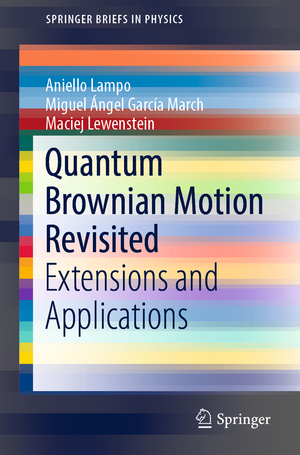Quantum Brownian Motion Revisited: Extensions and Applications: SpringerBriefs in Physics
Autor Aniello Lampo, Miguel Ángel García March, Maciej Lewensteinen Limba Engleză Paperback – 2 mai 2019
This book presents the main techniques aimed to treat the dynamics of the quantum Brownian particle: Born-Markov master equation, Lindblad equation and Heisenberg equations formalism. Particular attention is given to the interaction between the particle and the bath depends non-linearly on the position of the former. This generalization corresponds to the case in which the bath is not homogeneous. An immediate application is the Bose polaron, specifically an impurity embedded in an ultracold gas.
Din seria SpringerBriefs in Physics
-
 Preț: 346.92 lei
Preț: 346.92 lei -
 Preț: 381.00 lei
Preț: 381.00 lei -
 Preț: 380.07 lei
Preț: 380.07 lei -
 Preț: 200.36 lei
Preț: 200.36 lei -
 Preț: 312.68 lei
Preț: 312.68 lei -
 Preț: 476.95 lei
Preț: 476.95 lei -
 Preț: 311.69 lei
Preț: 311.69 lei -
 Preț: 387.24 lei
Preț: 387.24 lei -
 Preț: 477.94 lei
Preț: 477.94 lei - 17%
 Preț: 359.19 lei
Preț: 359.19 lei -
 Preț: 477.72 lei
Preț: 477.72 lei -
 Preț: 378.92 lei
Preț: 378.92 lei -
 Preț: 379.86 lei
Preț: 379.86 lei -
 Preț: 378.92 lei
Preț: 378.92 lei - 15%
 Preț: 461.73 lei
Preț: 461.73 lei -
 Preț: 413.07 lei
Preț: 413.07 lei -
 Preț: 377.18 lei
Preț: 377.18 lei - 15%
 Preț: 463.85 lei
Preț: 463.85 lei -
 Preț: 376.59 lei
Preț: 376.59 lei -
 Preț: 344.53 lei
Preț: 344.53 lei - 15%
 Preț: 462.70 lei
Preț: 462.70 lei -
 Preț: 475.06 lei
Preț: 475.06 lei -
 Preț: 377.73 lei
Preț: 377.73 lei -
 Preț: 345.89 lei
Preț: 345.89 lei -
 Preț: 378.12 lei
Preț: 378.12 lei - 15%
 Preț: 464.18 lei
Preț: 464.18 lei -
 Preț: 376.80 lei
Preț: 376.80 lei -
 Preț: 409.43 lei
Preț: 409.43 lei -
 Preț: 407.67 lei
Preț: 407.67 lei -
 Preț: 377.57 lei
Preț: 377.57 lei -
 Preț: 380.84 lei
Preț: 380.84 lei - 20%
 Preț: 387.05 lei
Preț: 387.05 lei -
 Preț: 377.73 lei
Preț: 377.73 lei -
 Preț: 380.07 lei
Preț: 380.07 lei -
 Preț: 376.80 lei
Preț: 376.80 lei - 15%
 Preț: 460.57 lei
Preț: 460.57 lei -
 Preț: 346.23 lei
Preț: 346.23 lei -
 Preț: 343.72 lei
Preț: 343.72 lei -
 Preț: 349.80 lei
Preț: 349.80 lei - 15%
 Preț: 463.53 lei
Preț: 463.53 lei -
 Preț: 376.04 lei
Preț: 376.04 lei -
 Preț: 376.22 lei
Preț: 376.22 lei -
 Preț: 376.80 lei
Preț: 376.80 lei -
 Preț: 475.65 lei
Preț: 475.65 lei -
 Preț: 375.07 lei
Preț: 375.07 lei - 15%
 Preț: 462.38 lei
Preț: 462.38 lei -
 Preț: 346.27 lei
Preț: 346.27 lei -
 Preț: 450.33 lei
Preț: 450.33 lei -
 Preț: 376.22 lei
Preț: 376.22 lei -
 Preț: 380.07 lei
Preț: 380.07 lei
Preț: 377.73 lei
Nou
Puncte Express: 567
Preț estimativ în valută:
72.28€ • 75.46$ • 59.82£
72.28€ • 75.46$ • 59.82£
Carte tipărită la comandă
Livrare economică 05-19 aprilie
Preluare comenzi: 021 569.72.76
Specificații
ISBN-13: 9783030168032
ISBN-10: 3030168034
Pagini: 126
Ilustrații: VI, 109 p. 22 illus., 20 illus. in color.
Dimensiuni: 155 x 235 mm
Greutate: 0.17 kg
Ediția:1st ed. 2019
Editura: Springer International Publishing
Colecția Springer
Seria SpringerBriefs in Physics
Locul publicării:Cham, Switzerland
ISBN-10: 3030168034
Pagini: 126
Ilustrații: VI, 109 p. 22 illus., 20 illus. in color.
Dimensiuni: 155 x 235 mm
Greutate: 0.17 kg
Ediția:1st ed. 2019
Editura: Springer International Publishing
Colecția Springer
Seria SpringerBriefs in Physics
Locul publicării:Cham, Switzerland
Cuprins
Introduction.- Classical Brownian motion.- Quantum Brownian motion.- Non-linear quantum Brownian motion.- A Lindblad model for quantum Brownian motion.- Heisenberg equations approach.- Conclusions and perspectives.- Heisenberg principle for density operators.- Gaussian approximation.- Bibliography.
Notă biografică
Aniello Lampo completed his PhD at the Institute of Photonic Science (ICFO) of Barcelona, focusing on complex quantum systems and quantum-to-classical transition. Currently, he works as junior postdoc at the Internet Interdisciplinary Institute (IN3) of Barcelona, in the CoSIN3 group (Complex Systems @ IN3) and studies diffusion phenomena in social networks. He is also interested in the philosophical and historical aspects of science, such as the political role of scientists and the relation between scientific research and society.
Miguel Ángel García March completed his PhD in Valencia with Albert Ferrando in the Pure and Applied Mathematics Institute (IUMPA), Polytechnic University of Valencia, with Extraordinary Excellence Award. Consequently, he worked as postdoc at IFISC (Mallorca), at Colorado School of Mines (CO, USA), at the University College Cork (Ireland), and at the University of Barcelona. Since 2014 he has been working at ICFO as Research Fellow in the group of Prof. Maciej Lewenstein. His scientific interests include nonlinear optics, singular optics, quantum physics, ultracold atoms, complex and open classical and quantum systems.
Maciej Lewenstein joined the Centre for Theoretical Physics of the Polish Academy of Sciences in Warsaw in 1980. He completed his PhD in Essen in 1983 with Fritz Haake and he obtained his habilitation in 1986 in Warsaw. He worked as postdoc at the University of Essen and at the Harvard University with Roy J. Glauber (Nobel prize 2005). He was faculty member of CEA in Saclay (1995-1998), and at the Leibniz University Hannover (1998-2005). In 2005 he moved to Catalonia as ICREA Research Professor to lead the quantum optics theory group at the Institut de Ciències Fotòniques in Castelldefels. His scientific interests include quantum optics, quantum physics, quantuminformation, many body theory, attosecond science, and statistical physics. His other passion is jazz and avant-garde music and he is an acclaimed jazz writer and critic.
Caracteristici
Provides a comprehensive historical overview of quantum Brownian motion All the calculations are explained in detail Gives an in depth exposition of the non-linear interaction generalization
